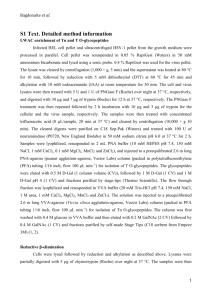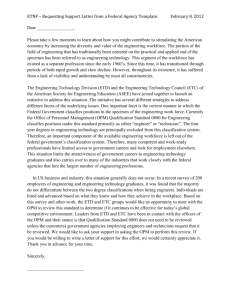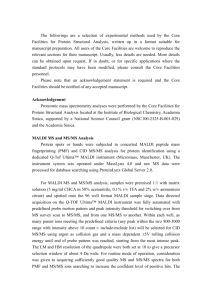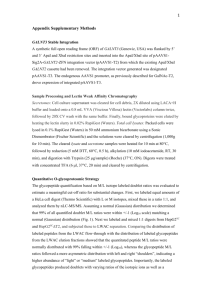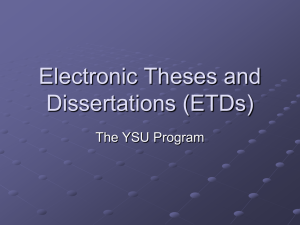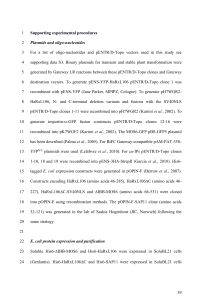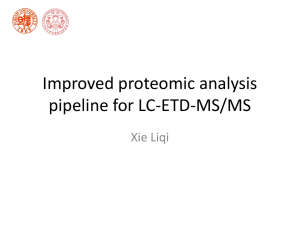A calibration routine for efficient ETD in large
advertisement
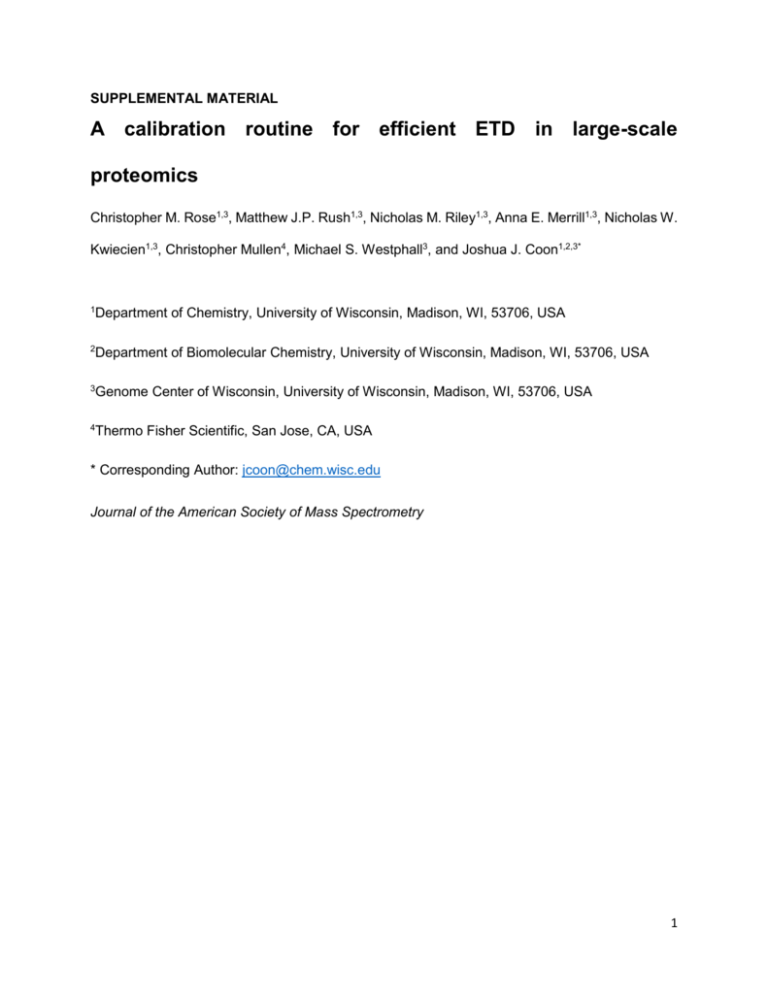
SUPPLEMENTAL MATERIAL A calibration routine for efficient ETD in large-scale proteomics Christopher M. Rose1,3, Matthew J.P. Rush1,3, Nicholas M. Riley1,3, Anna E. Merrill1,3, Nicholas W. Kwiecien1,3, Christopher Mullen4, Michael S. Westphall3, and Joshua J. Coon1,2,3* 1 Department of Chemistry, University of Wisconsin, Madison, WI, 53706, USA 2 Department of Biomolecular Chemistry, University of Wisconsin, Madison, WI, 53706, USA 3 Genome Center of Wisconsin, University of Wisconsin, Madison, WI, 53706, USA 4 Thermo Fisher Scientific, San Jose, CA, USA * Corresponding Author: jcoon@chem.wisc.edu Journal of the American Society of Mass Spectrometry 1 Extended Experimental Procedures Infusion of Angiotensin I: Angiotensin I was diluted to 2 pmol/µL in 50% ACN with 0.2% FA and directly infused using electrospray ionization. ETD was performed on the triply charge precursor for times ranging from 5 to 160 ms (in steps of 5). Yeast Sample Preparation: Yeast were lysed and proteins were reduced and alkylated as previously described.30 To create large highly charged peptides for the large scale analysis of optimal ETD reaction times, proteins were digested for 40 (final analysis of NRT) or 60 (analysis of product ion yield) min at ~4 °C after the addition of 1 mM CaCl2, 50 mM Tris (to decrease urea to 1 M for trypsin or 4 M for LysC digestion), and adjusting to pH 8 at an enzyme-to-substrate ratio of 1:250 of trypsin (Promega, Madison, WI, USA). For all other experiments the trypsin digestion was replaced by an overnight LysC (Wako) digestion at room temperature with an enzyme-tosubstrate ratio of 1:100. All digests were quenched by the addition of TFA to a final concentration of 0.5 % (pH 2), and desalted via solid phase extraction on a 50-mg tC18 SepPak cartridge (Waters, Milford, MA, USA). Database Searching and FDR Estimation: Data were searched against a database containing canonical protein and protein isoform sequences from Uniprot (6,563 total entries). For large scale analysis of optimal ETD reaction times the database search was performed using a precursor mass tolerance of ± 4.5 Th, Orbitrap MS2 product ion tolerance of ± 0.01 Th, and ion trap MS2 product ion tolerance of ± 0.35 Th while considering up to nine missed cleavages. For all other experiments, a precursor mass tolerance of ±150 ppm was used while considering four isotopes and three missed cleavages. Peptides were considered with carbamidomethylation of cysteine as a fixed modification and oxidation of methionine as a variable modification. Mass Spectrometry and High Performance Liquid Chromatography: For Large scale characterization of optimal reaction times precursors were selected from MS1 scans comprising 1,000,000 charges and collected at 60,000 resolution. Separate experiments collecting MS 2 2 events in the ion trap or Orbitrap (15,000 resolution) using 30,000 or 100,000 precursor charges, respectively. A ±10 ppm window was excluded around the monoisotopic peak of each precursor for 45 sec. Experiments evaluating normalized ETD reaction rates were either performed on an ETDenabled hybrid, dual cell-quadrupole ion trap-Orbitrap mass spectrometer (Orbitrap Elite) or a quadrupole-Orbitrap-quadrupole ion trap (Q-OT-qIT) hybrid mass spectrometer (Orbitrap Fusion, Thermo Fisher Scientific, San Jose, CA). For experiments performed on the Orbitrap Elite, MS 1 scans at a resolution of 60,000 were used to guide selection and dissociation of the 20 most intense precursors. Precursors with a charge greater than 2 were reacted with the calibrated number of reagent anions for the specified normalized reaction time and ETD product ions were analyzed in either the Orbitrap (100,000 precursor charges, 15,000 resolution) or the ion trap (30,000 precursor charges) in separate experiments. For both ion trap and Orbitrap analysis, one experiment was performed using an ETD reaction time of 100 ms for all precursors. Precursors were isolated at 1.8 Th and an exclusion window of ±10 ppm was constructed around the monoisotopic peak of each selected precursor for 45 sec. For experiments performed on the Orbitrap Fusion, MS1 scans guided the selection of precursors such that MS1 scans were performed every 5 sec. Precursors with a charge greater than 2 were reacted with either the calibrated number of reagent anions or 200,000 reagent anions for the calibrated ETD reaction time or 100 ms, respectively. ETD product ions were analyzed in either the ion trap (30,000 precursor charges) or Orbitrap (100,000 precursor charges, 15,000 resolution). Precursors were isolated using the quadrupole with an isolation window of ±0.7 Th and an exclusion window of ±10 ppm was constructed around the monoisotopic peak of each selected precursor for 45 sec. Large-Scale Analysis of ETD Product Ion Intensity: Determination of optimal ETD reaction times was performed on data collected using various ETD reaction times as a function of the charge state dependent time constant (τ). For each charge state (2-6) one LC-MS/MS analysis was 3 conducted analyzing ions in the ion trap and another analyzing ions in the Orbitrap, yielding two raw files for each charge state. Each LC-MS/MS experiment comprised an MS1 followed by eleven MS2 events that reacted the most intense precursor for various amounts of time ranging from 1 – 4τ. For each precursor (i.e., set of eleven MS2 events) the top scoring peptide hit was determined to be the correct identification and the resulting sequence was used to generate a list of all c or z-dot product ions. For precursors with charge greater than 3, m/z values relating to multiply charge product ions were also considered. Product ions were considered with a tolerance of 15 ppm and 0.5 Da for Orbitrap and ion trap analysis, respectively. For each MS2, product ions were summed and the resulting total was mapped to the appropriate multiple of τ. These values were subsequently normalized to the largest intensity within the set of reaction times (i.e., all MS2 spectra of the same precursor) resulting in a score of 0.0 to 1.0 for each multiple of τ and enabling the comparison of all identified peptides across the LC-MS/MS experiment. Precursors that included one or more MS2 scans that did not reach the requested number of ions (i.e., injection time equal to max inject time) were excluded from analysis. MS2 scans were collected at an ETD reaction time of 2τ for scan event two, seven, and twelve to ensure that elution of the peptide did not affect analysis. For ion trap analysis the first 2τ scan was collected in the Orbitrap to increase the probability of identification. 4 Supplemental Table 1. Charge state dependent ETD reaction rate and ETD time constant (τ), multiples 1 and 2. 5 SUPPLEMENTAL FIGURE LEGENDS Supplementary Fig 1. Experimental validation of optimal ETD reaction time. We performed large-scale experiments testing a range of reaction times for thousands of precursors with charge states ranging from +2 to +6. Panel A displays the number of reaction sets, i.e., peptide sequences, that were used to generate the data shown in Panels B – F. For each charge state the distribution of normalized product ion intensities are plotted as a function of reaction duration, as measured in either τ or milliseconds. These data were collected using the orbitrap mass analyzer. Supplementary Fig 2. Effect of the ETD reaction time constant (τ) for shotgun proteomics. Using a complex mixture of yeast peptides we conducted a set of nanoLC-MS/MS experiments using a designated multiple of the ETD time constant (i.e., 0 to 20 τ) for each. The summary of MS/MS scans, PSMs, and unique peptides resulting from each analysis are presented in Panel A. Panel B explores the tradeoff between success rates (ratio PSMs to MS/MS events) and unique peptide identifications. ETD time constant multiples of 1 to 2 produce the highest number of both peptide spectral matches (PSMs) and unique peptides. To correlate the quality of the ETD MS/MS spectrum with the number of peptides identified, we calculated the median peptide sequence coverage for all identified spectra. 2τ yields the highest median sequence coverage and delivers high numbers of unique identifications (Panel C). These data were collected using the orbitrap mass analyzer. Supplementary Fig 3. Implementation of calibrated ETD reaction time method for global proteomic analysis on a Q-OT-qIT hybrid. Results following the analysis of complex peptide mixtures using either calibrated or static ETD reaction times (A). Panel B displays representative spectra (VSIAGRIHAK, +3) demonstrating lower product ion yield in the 100 ms static reaction time (top) as compared to the calibrated ETD reaction time (~ 2τ or 46.8 ms, bottom). These data were collected using the orbitrap mass analyzer. 6 SUPPLEMENTAL FIGURE 1 7 SUPPLEMENTAL FIGURE 2 8 SUPPLEMENTAL FIGURE 3 9

